When we hear “argan oil,” most of us think about hair serums and face oils. But did you know that food-grade argan oil is also one of the most powerful culinary superfoods? Sourced directly from Moroccan argan trees and pressed using traditional methods, this liquid gold is not just delicious—it’s loaded with health benefits.
In this article, we explore what makes culinary argan oil so unique, its nutritional advantages, how it compares to other oils, pricing insights, product quality, reviews, and my personal opinion as a wellness blogger and real foodie.
What Is Food-Grade Argan Oil?
Food-grade argan oil is extracted from roasted argan kernels and used in Moroccan cuisine for centuries. It has a distinct nutty flavor and is often referred to as “Morocco’s liquid gold.”
Key Characteristics of Culinary Argan Oil
- Made from lightly roasted argan nuts
- Cold-pressed to preserve nutrients
- Rich, nutty taste
- Golden color with a smooth texture
- 100% natural and often certified organic (USDA Organic, Ecocert)
🧾 Read more about the nutritional content of argan oil via NCBI
The Health Benefits of Consuming Argan Oil
What truly sets food-grade argan oil apart is its exceptional nutritional profile.
Nutritional Advantages
- Packed with omega-6 and omega-9 fatty acids
- High in vitamin E, a powerful antioxidant
- Contains sterols and polyphenols that support heart health
- Natural anti-inflammatory properties
According to the Journal of Ethnopharmacology, regular consumption of culinary argan oil can help lower cholesterol, improve heart function, and support digestive health.
Culinary Uses of Argan Oil
This superfood isn’t just healthy—it’s also delicious.
How to Use It in Your Kitchen
- Drizzle over grilled vegetables or couscous
- Use in salad dressings with lemon and herbs
- Mix into smoothies for a nutty twist
- Add to breakfast bowls or yogurt
- Use as a finishing oil—not for frying
In Morocco, it’s traditionally eaten with bread and honey for breakfast, known as “Amlou”.
How It Differs from Cosmetic Argan Oil
Many people confuse food-grade argan oil with its cosmetic counterpart, but there are important differences:
| Feature | Food-Grade Argan Oil | Cosmetic Argan Oil |
|---|---|---|
| Source | Roasted kernels | Raw kernels |
| Taste | Nutty and rich | Not edible |
| Uses | Culinary | Skincare and hair |
| Certification | Food safety standards | Cosmetic-grade testing |
| Extraction | Cold-pressed after roasting | Cold-pressed, no roast |
Always ensure the bottle is labeled as edible and comes from a certified source.
Price of Culinary Argan Oil
What You Can Expect to Pay
- 100ml bottle: $15–$30
- 250ml bottle: $25–$60
- Bulk pricing: Available for B2B or culinary brands
Yes, it’s more expensive than olive or sunflower oil, but the price reflects:
- Traditional harvesting methods
- Limited geographic growth area (only in Morocco)
- Fair trade and organic production
- Nutritional and health value
Get fresh, certified culinary argan oil directly from Moroccan producers at argan-oil.ma.
Product Quality and Authenticity
Authentic food-grade argan oil goes through rigorous quality control and follows traditional methods. Unlike many mass-market oils, it’s:
- Pressed in small batches
- Packaged in glass bottles to protect nutrients
- Produced by women-led cooperatives using ancestral knowledge
- Verified by international food safety standards
Sadly, some low-cost oils are diluted or even fake. For guaranteed authenticity, choose certified suppliers with traceable origin.
What People Are Saying
“This oil has changed my kitchen habits. I use it on everything from quinoa to roasted eggplant.” – Lena, France
“Argan oil adds a gourmet touch to my meals and helps my digestion too.” – Omar, Canada
“After tasting it at a Moroccan market, I had to bring some home. Now I buy directly from argan-oil.ma.” – Julia, UK
My Blogger Review: Why I Love Culinary Argan Oil
As a food and wellness blogger, I try dozens of oils—but none compare to culinary argan oil. After tasting it during a trip to Morocco, I fell in love. It has the richness of sesame oil, the smoothness of olive oil, and a flavor that elevates even the simplest dishes.
More importantly, I value products that do good while tasting good. When I buy from trusted cooperatives, I know I’m supporting women’s employment, ethical farming, and a centuries-old food tradition.
It’s now a staple in my kitchen—and a beautiful story I get to share with every dish I make.
Conclusion
Culinary argan oil is more than just a superfood—it’s a product of tradition, sustainability, and nutritional excellence. Whether you’re a home cook, a wellness seeker, or a professional chef, adding food-grade Moroccan argan oil to your diet is a delicious and meaningful choice.
👉 Ready to taste the difference? Get your bottle directly from https://argan-oil.ma



